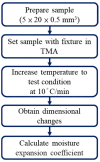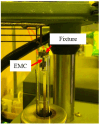Hygrothermal Stress Analysis of Epoxy Molding Compound in Fan-Out Panel-Level Package Based on Experimental Characterization and Structural Sensitivity
- PMID: 40808082
- PMCID: PMC12349150
- DOI: 10.3390/polym17152034
Hygrothermal Stress Analysis of Epoxy Molding Compound in Fan-Out Panel-Level Package Based on Experimental Characterization and Structural Sensitivity
Abstract
As semiconductor devices demand higher input-output density and faster signal transmission, fan-out panel-level packaging has emerged as a promising solution for next-generation electronic systems. However, the hygroscopic nature of epoxy molding compounds raises critical reliability concerns under high-temperature and high-humidity conditions. This study investigates the hygrothermal stress of a single fan-out panel-level package unit through experimental characterization and numerical simulation. Thermal-mechanical analysis was conducted at 100 °C and 260 °C to evaluate the strain behavior of two commercial epoxy molding compounds in granule form after moisture saturation. The coefficient of moisture expansion was calculated by correlating strain variation with moisture uptake obtained under 85 °C and 85% relative humidity, corresponding to moisture sensitivity level 1 conditions. These values were directly considered into a moisture -thermal coupled finite element analysis. The simulation results under reflow conditions demonstrate accurate principal stress and failure location predictions, with stress concentrations primarily observed at the die corners. The results confirm that thermal effects influence stress development more than moisture effects. Finally, a structural sensitivity analysis of the single-package configuration showed that optimizing the thickness of the dies and epoxy molding compound can reduce maximum principal stress by up to 12.4%, providing design insights for improving package-level reliability.
Keywords: fan-out panel-level packaging; hygrothermal stress; moisture effect; reliability; structural sensitivity analysis.
Conflict of interest statement
Authors Wen-Hsiang Liao and Yong-Jie Zeng were employed in Packaging Product Simulation and Design, Innolux Corporation, Tainan, Taiwan; author Cheng-Tse Tsai was employed at the Testing Center, Innolux Corporation, Tainan, Taiwan. The remaining authors declare that the research was conducted in the absence of any commercial or financial relationships that could be construed as a potential conflict of interest.
Figures
































Similar articles
-
Prescription of Controlled Substances: Benefits and Risks.2025 Jul 6. In: StatPearls [Internet]. Treasure Island (FL): StatPearls Publishing; 2025 Jan–. 2025 Jul 6. In: StatPearls [Internet]. Treasure Island (FL): StatPearls Publishing; 2025 Jan–. PMID: 30726003 Free Books & Documents.
-
Management of urinary stones by experts in stone disease (ESD 2025).Arch Ital Urol Androl. 2025 Jun 30;97(2):14085. doi: 10.4081/aiua.2025.14085. Epub 2025 Jun 30. Arch Ital Urol Androl. 2025. PMID: 40583613 Review.
-
Portion, package or tableware size for changing selection and consumption of food, alcohol and tobacco.Cochrane Database Syst Rev. 2015 Sep 14;2015(9):CD011045. doi: 10.1002/14651858.CD011045.pub2. Cochrane Database Syst Rev. 2015. PMID: 26368271 Free PMC article.
-
How Does Chondrolabral Damage and Labral Repair Influence the Mechanics of the Hip in the Setting of Cam Morphology? A Finite-Element Modeling Study.Clin Orthop Relat Res. 2022 Mar 1;480(3):602-615. doi: 10.1097/CORR.0000000000002000. Clin Orthop Relat Res. 2022. PMID: 34766936 Free PMC article.
-
Sexual Harassment and Prevention Training.2024 Mar 29. In: StatPearls [Internet]. Treasure Island (FL): StatPearls Publishing; 2025 Jan–. 2024 Mar 29. In: StatPearls [Internet]. Treasure Island (FL): StatPearls Publishing; 2025 Jan–. PMID: 36508513 Free Books & Documents.
References
-
- Motohashi N., Kimura T., Mineo K., Yamada Y., Nishiyama T., Shibuya K., Kobayashi H., Kurita Y., Kawano M. System in Wafer-Level Package Technology with RDL-first Process; Proceedings of the IEEE 61st Electronic Components and Technology Conference; Lake Buena Vista, FL, USA. 31 May–3 June 2011; pp. 59–64.
-
- Chen S., Wang S., Hunt J., Chen W., Liang L., Kao G., Peng A. A Comparative Study of a Fan-Out Packaged Product: Chip First and Chip Last; Proceedings of the IEEE 66th Electronic Components and Technology Conference; Las Vegas, NV, USA. 31 May–3 June 2016; pp. 1483–1488.
-
- Lau J.H., Ko C.-T., Yang K.-M., Peng C.-Y., Xia T., Lin P.B., Chen J., Huang P.P.-C., Liu H.-N., Tseng T.-J. Panel-Level Fan-Out RDL-first Packaging for Heterogeneous Integration. IEEE Trans. Compon. Packag. Manuf. Technol. 2020;10:1125–1137. doi: 10.1109/TCPMT.2020.2996658. - DOI
-
- Wong E.-H., Park S. Moisture Diffusion Modeling—A Critical Review. Microelectron. Reliab. 2016;65:318–326. doi: 10.1016/j.microrel.2016.08.009. - DOI
-
- Wong E.-H., Teo Y.-C., Lim T.-B. Moisture Diffusion and Vapor Pressure Modeling of IC Packaging; Proceedings of the IEEE 48th Electronic Components and Technology Conference; Seattle, WA, USA. 25–28 May 1998; pp. 1372–1378.
LinkOut - more resources
Full Text Sources
Research Materials

